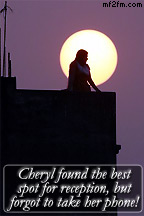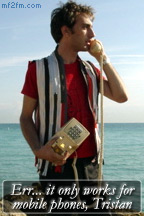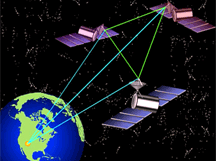Sunday 23 December, 2012, 23:02 - Radio Randomness, Satellites, Much Ado About Nothing
Posted by Administrator
It seems there are very few songs which touch on the topic of satellite communications unless you count:Posted by Administrator
- Sleeping Satellite by Tasmin Archer;
- Satellite by Lena (Germany's Eurovision winner in 2010); and
- Satellite by Oceanlab.
I'm just talking to a satellite,
Twenty thousand miles up in the sky each night
Taken from Electric Light Orchestra's Calling America.
There’s also:
I saw two shooting stars last night,
I wished on them but they were only satellites,
It's wrong to wish on space hardware.
I wish, I wish, I wish you'd care.
Taken from Kirsty Macoll's New England.
So it was nice to be alerted to a piece of work which is not only about satellites, but is very specifically endorsing the use of C-Band satellite services (3400 – 4200 MHz) over and above the use of Ku-Band (10700 – 12500 MHz) in sub-Saharan Africa where C-Band reception is more reliable than Ku-Band due to the fact that it deals with rain fading much better than Ku-Band does.
The song is by Cameroonian artist Wes. In it, he laments the loss of his Ku-band equipment, and the main thrust of the song is that he is short of some solder with which to complete the installation of his new C-Band parts. The video has him stood in front of his non-functional C-Band dish whilst his team try to dance their way into fixing the problem. Eventually they set off on a trek to try and get him some solder as the dancing, no matter how energetic, is clearly not working.
The only odd thing is that there is an Asian lady who, all the way through the song, keeps going on about her blasted spade. Still, it all adds to the ambiance.
The song is called ‘Soldery Song’, and you will need to watch the video whilst at the same time reading the lyrics below as it is quite hard to follow what he is saying due to his strong African English accent (the spade lady's incessant moaning about her spade is shown in brackets)...
SOLDERY SONG – WES
Soldery Song – Wes by jibou
(My Spade, where’s my spade?)
Soldery song: me need a solder
Me got me some parts, now it's me too,
Old part me chuck, and new me part, yeh?
Soldery song: me need me a soldery solder
Me got me some parts, now it's me too,
Old part me chuck, and me new part, yeh?
I throw a my Ku away, melt some solder, done my way
I throw a my Ku away, melt some solder, done my way
Bring us C-band way (with a spade?)
One-a-where they can go?
Hey, I meant to check.
(Spade, yeh, yeh, yeh, yeh!) x 2
Soldery song: hoo hoo hoo hoo hoo, me need a solder
Me got me some parts, now it's me too,
Old part me chuck and new me part, yeh?
I throw a my Ku away, melt some solder, done my way
I throw a my Ku away, melt some solder, done my way
Bring us C-band way (with a spade?)
One-a-where they can go?
Hey, I meant to check.
(Spade, yeh, yeh, yeh, yeh!) x 2
No more can I Ku, new me parts C-band
No more can I Ku, new me parts knackered!
No more can I Ku, new me parts C-band
No more can I Ku, new me parts knackered!
No more can I Ku, new me parts C-band
No more can I Ku, new me parts knackered!
I throw a my Ku away, melt some solder, done my way x 4
Bring us C-band way (with a spade?)
One-a-where they can go?
(Spade, yeh, yeh, yeh, yeh!)
Bring us C-band way (with a spade?)
One-a-where they can go?
Hey, I meant to check.
No more can I Ku, new me parts C-band
No more can I Ku, new me parts knackered!
No more can I Ku, new me parts C-band
No more can I Ku...
(Spade, yeh, yeh, yeh, yeh!)
Perhaps some kind Wireless Waffle reader could purchase some solder and send it to Wes to get his C-band equipment up and working. Oh, and whilst you’re at it, give the poor lady a spade too.
1 comment
( 2211 views )
| permalink
| 



 ( 2.9 / 8624 )
( 2.9 / 8624 )




 ( 2.9 / 8624 )
( 2.9 / 8624 )
Monday 4 June, 2012, 21:29 - Much Ado About Nothing
Posted by Administrator
A friend recently alerted us to the fact that 'fjarskiptastofnun' is the Icelandic word for 'telecommunications'. Is this the best word for 'telecommunications' you have ever heard? Maybe, then again maybe not. Here are Wireless Waffle's favourite foreign phrases for the word 'telecommunications'.Posted by Administrator
Armenian: Հեռահաղորդակցման
Finnish: tietoliikenne
Georgian: სატელეკომუნიკაციო
Hungarian: távközlés
Irish: teileachumarsáide
Maltese: telekomunikazzjonijiet
Nonsense: dreskidooloo beepbeep
Swahili: mawasiliano ya simu
Vietnamese: viễn thông
Welsh: telathrebu by there, see?
 Ofcom has recently published a leaflet outlining how mobile subscribers can go about maximising their mobile signal with a view to getting the best possible coverage. The leaflet covers issues such as checking coverage first, before buying a phone (shops have on-line coverage checkers available), trying out different operators (by testing different SIM cards) and has a few technical measures such as the use of Femtocells (tiny mobile base stations you can install in your own home) and UMA (carrying your voice traffic over WiFi when you're in the coverage of a suitable hotspot).
Ofcom has recently published a leaflet outlining how mobile subscribers can go about maximising their mobile signal with a view to getting the best possible coverage. The leaflet covers issues such as checking coverage first, before buying a phone (shops have on-line coverage checkers available), trying out different operators (by testing different SIM cards) and has a few technical measures such as the use of Femtocells (tiny mobile base stations you can install in your own home) and UMA (carrying your voice traffic over WiFi when you're in the coverage of a suitable hotspot).This is all well and good, and reasonable advice, but it doesn't cover how you might go about getting a better signal if you are stuck in an area with poor coverage. So here's the (new look!) Wireless Waffle guide to practical things you can do to get a better signal (and things that don't work).
 Get high! By far the best way to improve your chances of getting a good signal is to get your phone as high as possible. Signals upstairs will be better than signals downstairs. Signals at the top of a hill will be better than at the bottom. Standing on the roof of your car will get a better signal than sitting inside it (not recommended if you are a bit on the heavy side). Height is the number one way to boost your signal.
Get high! By far the best way to improve your chances of getting a good signal is to get your phone as high as possible. Signals upstairs will be better than signals downstairs. Signals at the top of a hill will be better than at the bottom. Standing on the roof of your car will get a better signal than sitting inside it (not recommended if you are a bit on the heavy side). Height is the number one way to boost your signal.Get out! The Ofcom paper mentions this too, but doesn't point out how big a difference it can make. Buildings can shield mobile signals by anything up to a factor of 50. Standing outside will circumvent this shielding and can make a big difference in your chances of success.
Get moving! Buildings not only shield signals inside them but can block signals from passing through them. Other big obstructions such as gasometers, walls, and even trees and cars
can also block signals. As you are unlikely to know which direction the mobile signal you are trying to receive is coming from, you may inadvertently be stood in a position where it is being blocked. Move around (in particular walk around a building) whilst checking the signal on your phone to see if there is a spot where it suddenly comes to life.
 Get naked! Whilst we would love to see people walking around buildings in the nude to try and get a better phone signal, by this we mean taking off any covers, shells or other accoutremenets which adorn your phone. Some covers can contain metal elements which can deflect mobile signals, especially if they end up covering up the antenna on your phone. Operating your phone 'naked' will ensure that it's antenna is not blocked or covered in any way and can further improve performance.
Get naked! Whilst we would love to see people walking around buildings in the nude to try and get a better phone signal, by this we mean taking off any covers, shells or other accoutremenets which adorn your phone. Some covers can contain metal elements which can deflect mobile signals, especially if they end up covering up the antenna on your phone. Operating your phone 'naked' will ensure that it's antenna is not blocked or covered in any way and can further improve performance.Get clear! Most electrical devices, especially computers, TVs, set top boxes and other electronic gizmos give off weak radio interference. The amount they give off is limited by law, but in close proximity it can be enough to upset mobile reception. Make sure you are as far as possible away from any electronic equipment and the interference they generate should be too weak to cause reception problems.
Get plugged in! If your phone has option to connect an external antenna (such as via a car-kit) it might be feasible to connect an free-standing aerial (such as these) to it. The antennas inside phones are a compromise in size, designed to peform as well as possible given the small space in which they have to fit. Plugging in a proper, full-size, external aerial will boost signals, especially if the aerial concerned is high up, outside and clear of any blockages.
Of course, these are the easy answers. There are some more technical solutions that require a bit of effort, like the soup can booster antenna (no, not two cans and piece of string) which really work. As well as things that do help, there are a number of things that don't...
 Power Strip Antenna Boosters and similar devices that you stick on your phone that claim to be able to improve its performance. Anything that doesn't plug into your phone but just sticks to it is highly unlikely to do anything other than leave a sticky patch when you remove it.
Power Strip Antenna Boosters and similar devices that you stick on your phone that claim to be able to improve its performance. Anything that doesn't plug into your phone but just sticks to it is highly unlikely to do anything other than leave a sticky patch when you remove it.Passive repeaters are a bit of a grey area. Properly installed they may be able to provide some boost in signal indoors, by taking the signal that is received outside and relaying it to the inside. The increase is only likely to be noticeable if you mount the external antenna as high as possible, use very high quality cable to connect the two ends, and stand right next to the internal antenna.
Active repeaters are also a grey area, but for a different reason. They do actually work, and can improve mobile signals if properly installed. But, and it's a big BUT, they are illegal to operate. The only people licensed to use them are the mobile operators themselves. Anyone else using one is breaking the law. Further, if they are badly installed, they can cause interference to the mobile networks actually making reception significantly worse, not just for you, but for everyone else in the area too!
So hopefully you now have a much better idea of what works and what doesn't and can amaze your friends by shouting out the mantra of 'get high, get moving, get naked and get clear' if they are suffering reception problems. They are sure to understand what you mean as you couldn't possibly be misinterpreted, could you?
According to an article in last Friday's London Evening Standard, the term 'pinging' means locating a mobile phone by satellite. Now Wireless Waffle has previously explained that GPS satellites can not track your location due to the fact that they only transmit location information, not receive it. So how did the News of the World manage to 'ping' the location of a mobile phone using satellite?
 As it couldn't have been GPS, the most obvious solution is that the satellites used to deliver Sky television are not just 'Sky satellites' but 'spy satellites' too! For this to work, the satellites concerned would have to be able to receive a signal from the phone being tracked, identify the direction from which the signal was being received, and then triangulate this through measurements from a number of different locations.
As it couldn't have been GPS, the most obvious solution is that the satellites used to deliver Sky television are not just 'Sky satellites' but 'spy satellites' too! For this to work, the satellites concerned would have to be able to receive a signal from the phone being tracked, identify the direction from which the signal was being received, and then triangulate this through measurements from a number of different locations.
 Let's take these one at a time. A geostationary satellite can 'see' about a third of the surface area of the earth. The image on the right shows the view from a satellite sat directly above the Greenwich Meridian. This puts it in clear line-of-sight of at least a third of the Earth's population (and probably more given that the pacific area is largely empty). So could it 'see' a mobile phone in the UK, yes! However, it would also see around a billion other mobile phones. Even if it had a very sharp 'spot beam' focussed solely on the UK (and remember that some celebrities may not be in the UK when pinged) it would still see probably a hundred million phones. Identifying the particular one being used by a certain individual is therefore not at all straightforward. Modern digital signal processing might be able to help a little, but with millions of mobile phones all transmitting at the same time, right across the country, it would take an awful lot of processing to pinpoint just one phone.
Let's take these one at a time. A geostationary satellite can 'see' about a third of the surface area of the earth. The image on the right shows the view from a satellite sat directly above the Greenwich Meridian. This puts it in clear line-of-sight of at least a third of the Earth's population (and probably more given that the pacific area is largely empty). So could it 'see' a mobile phone in the UK, yes! However, it would also see around a billion other mobile phones. Even if it had a very sharp 'spot beam' focussed solely on the UK (and remember that some celebrities may not be in the UK when pinged) it would still see probably a hundred million phones. Identifying the particular one being used by a certain individual is therefore not at all straightforward. Modern digital signal processing might be able to help a little, but with millions of mobile phones all transmitting at the same time, right across the country, it would take an awful lot of processing to pinpoint just one phone.
Let's assume (for the sake of argument) that such processing could be fitted to a satellite and that it was possible to pick out one phone from amongst millions. The next job is to identify the direction of the signal from that phone. In order to do this to an accuracy of, say 1km, from geostationary orbit, requires an angular accuracy of about 0.01 degrees. To get this level of focus requires an antenna array that is approximately 1km across, nearly 100 times the maximum size of antennas fitted to current communication satellites.
 So assuming state-of-the-art digital signal processing, and satellites that are 100 times the size of those typically in use, all that remains is to triangulate the location of the transmitter. Typically three measurements are required in order to triangulate the location of an object. All the UK Sky TV satellites are in the same orbital position, but this would not give the level of diversity required and so satellites in other positions would need to be used in addition to the fleet used for the UK services. But as there are Sky TV services for other countries on other satellites in diverse orbital positions, these could be used. This bit, at least, is vaguely feasible.
So assuming state-of-the-art digital signal processing, and satellites that are 100 times the size of those typically in use, all that remains is to triangulate the location of the transmitter. Typically three measurements are required in order to triangulate the location of an object. All the UK Sky TV satellites are in the same orbital position, but this would not give the level of diversity required and so satellites in other positions would need to be used in addition to the fleet used for the UK services. But as there are Sky TV services for other countries on other satellites in diverse orbital positions, these could be used. This bit, at least, is vaguely feasible.
So with a fleet of gigantic, super-powerful, mega-satellites, it might just be possible to identify the location of a mobile phone from space. It is more likely, however, that the idea that 'pinging' a phone to locate it by satellite is pure hogwash, and is an idea espoused by the press to scare celebrities and others (like you and me) into thinking that they can be tracked down when up to no good!

 As it couldn't have been GPS, the most obvious solution is that the satellites used to deliver Sky television are not just 'Sky satellites' but 'spy satellites' too! For this to work, the satellites concerned would have to be able to receive a signal from the phone being tracked, identify the direction from which the signal was being received, and then triangulate this through measurements from a number of different locations.
As it couldn't have been GPS, the most obvious solution is that the satellites used to deliver Sky television are not just 'Sky satellites' but 'spy satellites' too! For this to work, the satellites concerned would have to be able to receive a signal from the phone being tracked, identify the direction from which the signal was being received, and then triangulate this through measurements from a number of different locations.  Let's take these one at a time. A geostationary satellite can 'see' about a third of the surface area of the earth. The image on the right shows the view from a satellite sat directly above the Greenwich Meridian. This puts it in clear line-of-sight of at least a third of the Earth's population (and probably more given that the pacific area is largely empty). So could it 'see' a mobile phone in the UK, yes! However, it would also see around a billion other mobile phones. Even if it had a very sharp 'spot beam' focussed solely on the UK (and remember that some celebrities may not be in the UK when pinged) it would still see probably a hundred million phones. Identifying the particular one being used by a certain individual is therefore not at all straightforward. Modern digital signal processing might be able to help a little, but with millions of mobile phones all transmitting at the same time, right across the country, it would take an awful lot of processing to pinpoint just one phone.
Let's take these one at a time. A geostationary satellite can 'see' about a third of the surface area of the earth. The image on the right shows the view from a satellite sat directly above the Greenwich Meridian. This puts it in clear line-of-sight of at least a third of the Earth's population (and probably more given that the pacific area is largely empty). So could it 'see' a mobile phone in the UK, yes! However, it would also see around a billion other mobile phones. Even if it had a very sharp 'spot beam' focussed solely on the UK (and remember that some celebrities may not be in the UK when pinged) it would still see probably a hundred million phones. Identifying the particular one being used by a certain individual is therefore not at all straightforward. Modern digital signal processing might be able to help a little, but with millions of mobile phones all transmitting at the same time, right across the country, it would take an awful lot of processing to pinpoint just one phone.Let's assume (for the sake of argument) that such processing could be fitted to a satellite and that it was possible to pick out one phone from amongst millions. The next job is to identify the direction of the signal from that phone. In order to do this to an accuracy of, say 1km, from geostationary orbit, requires an angular accuracy of about 0.01 degrees. To get this level of focus requires an antenna array that is approximately 1km across, nearly 100 times the maximum size of antennas fitted to current communication satellites.
 So assuming state-of-the-art digital signal processing, and satellites that are 100 times the size of those typically in use, all that remains is to triangulate the location of the transmitter. Typically three measurements are required in order to triangulate the location of an object. All the UK Sky TV satellites are in the same orbital position, but this would not give the level of diversity required and so satellites in other positions would need to be used in addition to the fleet used for the UK services. But as there are Sky TV services for other countries on other satellites in diverse orbital positions, these could be used. This bit, at least, is vaguely feasible.
So assuming state-of-the-art digital signal processing, and satellites that are 100 times the size of those typically in use, all that remains is to triangulate the location of the transmitter. Typically three measurements are required in order to triangulate the location of an object. All the UK Sky TV satellites are in the same orbital position, but this would not give the level of diversity required and so satellites in other positions would need to be used in addition to the fleet used for the UK services. But as there are Sky TV services for other countries on other satellites in diverse orbital positions, these could be used. This bit, at least, is vaguely feasible.So with a fleet of gigantic, super-powerful, mega-satellites, it might just be possible to identify the location of a mobile phone from space. It is more likely, however, that the idea that 'pinging' a phone to locate it by satellite is pure hogwash, and is an idea espoused by the press to scare celebrities and others (like you and me) into thinking that they can be tracked down when up to no good!


